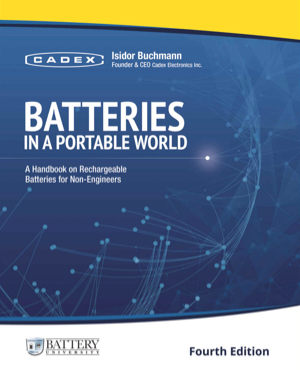12v 2a 6a Battery Charger How to Read the Needle
Find which charger is best for your awarding
A good bombardment charger provides the base for batteries that are durable and perform well. In a toll-sensitive marketplace, chargers ofttimes receive low priority and get the "subsequently-thought" status. Bombardment and charger must go together like a equus caballus and carriage. Prudent planning gives the power source height priority by placing information technology at the beginning of the projection rather than after the hardware is completed, as is a mutual practice. Engineers are oft unaware of the complication involving the ability source, peculiarly when charging nether agin conditions.

One does not deliver without the other.
Chargers are commonly identified by their charging speed. Consumer products come up with a low-cost personal charger that performs well when used as directed. The industrial charger is often made by a third political party and includes special features, such as charging at agin temperatures. Although batteries operate below freezing, not all chemistries tin can be charged when cold and virtually Li-ions fall into this category. Lead- and nickel-based batteries have charge when cold just at a lower rate. (See BU-410: Charging at High and Low Temperature)
Some Li-ion chargers (Cadex) include a wake-up feature, or "boost," to allow recharging if a Li-ion battery has fallen comatose due to over-discharge. A sleep condition can occur when storing the battery in a discharged country in which self-discharge brings the voltage to the cut-off point. A regular charger treats such a battery as unserviceable and the pack is oft discarded. Heave applies a small charge current to raise the voltage to between 2.2V/cell and two.9V/cell to activate the protection circuit, at which point a normal charge commences. Circumspection is required if a Li-ion has dwelled below one.5V/cell for a week or longer. Dendrites may take adult that could compromise safety. (See BU-802b: What does Elevated Self-belch Do? in which Figures 5 examines the elevated self-discharge after a Li-ion cell had been exposed to deep discharge. Run across also BU-808a: How to Awaken Sleeping Li-ion)
Lead- and lithium-based chargers operate on constant electric current constant voltage (CCCV). The charge current is constant and the voltage is capped when it reaches a set limit. Reaching the voltage limit, the battery saturates; the current drops until the bombardment tin can no longer accept further charge and the fast charge terminates. Each bombardment has its own low-current threshold.
Nickel-based batteries accuse with constant current and the voltage is allowed to rise freely. This tin be compared to lifting a weight with a rubber ring where the hand advances higher than the load. Full accuse detection occurs when observing a slight voltage drib after a steady rising. To safeguard against anomalies, such as shorted or mismatched cells, the charger should include a plateau timer to assure a safety accuse termination if no voltage delta is detected. Temperature sensing should also be added that measures temperature rise over fourth dimension. Such a method is known equally delta temperature over delta time, or dT/dt, and works well with rapid and fast charge.
A temperature rise is normal with nickel-based batteries, peculiarly when reaching the lxx percentage charge level. A decrease in accuse efficiency causes this, and the charge current should be lowered to limit stress. When "ready," the charger switches to trickle accuse and the bombardment must cool down. If the temperature stays above ambience, then the charger is not performing correctly and the battery should exist removed because the trickle charge could be likewise high.
NiCd and NiMH should not be left in the charger unattended for weeks and months. Until required, store the batteries in a absurd place and use a charge before apply.
Lithium-based batteries should ever stay cool on charge. Discontinue the utilize of a battery or charger if the temperature rises more than 10ºC (18ºF) above ambience under a normal charge. Li ion cannot absorb over-charge and does non receive trickle charge when total. It is not necessary to remove Li-ion from the charger; even so, if not used for a week or more than, it is best to place the pack in a cool place and recharge earlier utilize.
Types of Chargers
The most bones charger was the overnight charger, also known every bit a ho-hum charger. This goes dorsum to the old nickel-cadmium days where a simple charger practical a fixed charge of nigh 0.1C (one-tenth of the rated capacity) as long as the battery was connected. Slow chargers have no full-charge detection; the charge stays engaged and a full accuse of an empty battery takes 14–sixteen hours. When fully charged, the slow charger keeps NiCd lukewarm to the bear on. Considering of its reduced power to blot over-accuse, NiMH should not be charged on a dull charger. Low-cost consumer chargers charging AAA, AA and C cells often deploy this charge method, and so do some children's toys. Remove the batteries when warm.
The rapid charger falls betwixt the slow and fast charger and is used in consumer products. The accuse time of an empty pack is three–vi hours. When full, the charger switches to "prepare." Most rapid chargers include temperature sensing to safely charge a faulty battery.
The fast charger offers several advantages and the obvious one is shorter charge times. This demands tighter communication between the charger and bombardment. At a charge rate of 1C, (see BU-402:What is C-rate?) which a fast charger typically uses, an empty NiCd and NiMH charges in a fiddling more than an hour. As the battery approaches full charge, some nickel-based chargers reduce the current to conform to the lower charge acceptance. The fully charged battery switches the charger to trickle accuse, also known as maintenance charge. About of today's nickel-based chargers take a reduced trickle charge to also accommodate NiMH.
Li-ion has minimal losses during charge and the coulombic efficiency is ameliorate than 99 percentage. At 1C, the bombardment charges to lxx percentage state-of-charge (SoC) in less than an hr; the extra time is devoted to the saturation charge. Li-ion does not require the saturation charge equally pb acrid does; in fact information technology is better not to fully charge Li-ion — the batteries will concluding longer but the runtime will be a niggling less. Of all chargers, Li-ion is the simplest. No trickery applies that promises to improve bombardment performance equally is often claimed by makers of chargers for lead- and nickel-based batteries. Only the rudimentary CCCV method works.
Lead acrid cannot be fast charged and the term "fast-charge" is a misnomer. Most lead acrid chargers accuse the bombardment in xiv–xvi hours; annihilation slower is a compromise. Lead acid can be charged to 70 pct in about viii hours; the earth-shaking saturation charge takes up the remaining fourth dimension. A partial accuse is fine provided the lead acrid occasionally receives a fully saturated charge to forestall sulfation.
The standby current on a charger should be low to salvage energy. Energy Star assigns v stars to mobile phone chargers and other pocket-sized chargers drawing 30mW or less on standby. Iv stars become to chargers with 30–150mW, three stars to 150–250mW and ii stars to 250–350mW. The boilerplate consumption is 300mW and these units get one star. Energy Star aims to reduce current consumption of personal chargers that are mostly left plugged in when not in utilise. There are over one billion such chargers connected to the gird globally at any given time.
Simple Guidelines when Buying a Charger
- Charging a battery is most effective when its state-of-charge (SoC) is depression. Accuse credence decreases when the bombardment reaches a SoC of 70% and higher. A fully charged battery tin can no longer convert electric energy into chemical energy and charge must be lowered to trickle or terminated.
- Filling a battery beyond full state-of-charge turns backlog energy into heat and gas. With Li-ion, this can result in a eolith of unwanted materials. Prolonged over-charge causes permanent damage.
- Use the correct charger for the intended battery chemistry. Most chargers serve ane chemistry merely. Make sure that the battery voltage agrees with the charger. Practise not charge if unlike.
- The Ah rating of a battery can be marginally different than specified. Charging a larger battery will accept a bit longer than a smaller pack and vice versa. Do not charge if the Ah rating deviates as well much (more than than 25 percent).
- A high-wattage charger shortens the charge fourth dimension only there are limitations as to how fast a battery can be charged. Ultra-fast charging causes stress.
- A pb acid charger should switch to float charge when fully saturated; a nickel-based charger must switch to trickle accuse when total. Li-ion cannot absorb overcharge and receives no trickle charge. Trickle charge and float charges recoup for the losses incurred past self-discharge.
- Chargers should have a temperature override to finish charge on a faulty bombardment.
- Find charge temperature. Pb acrid batteries should stay lukewarm to the touch; nickel-based batteries will get warm towards the end of charge but must cool downward on "ready." Li-ion should non ascension more 10ºC (18ºF) above ambient when reaching full charge.
- Check battery temperature when using a low-cost charger. Remove battery when warm.
- Charge at room temperature. Charge acceptance drops when cold. Li-ion cannot be charged below freezing.

Batteries In A Portable World
Source: https://batteryuniversity.com/article/bu-401-how-do-battery-chargers-work
0 Response to "12v 2a 6a Battery Charger How to Read the Needle"
Post a Comment